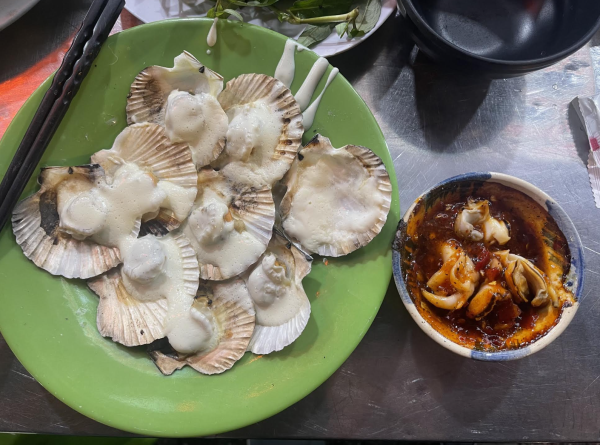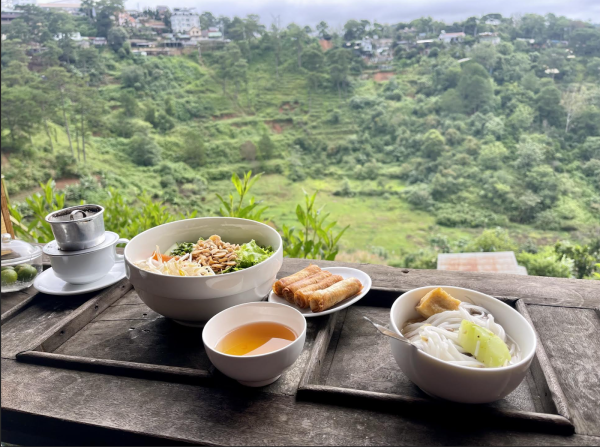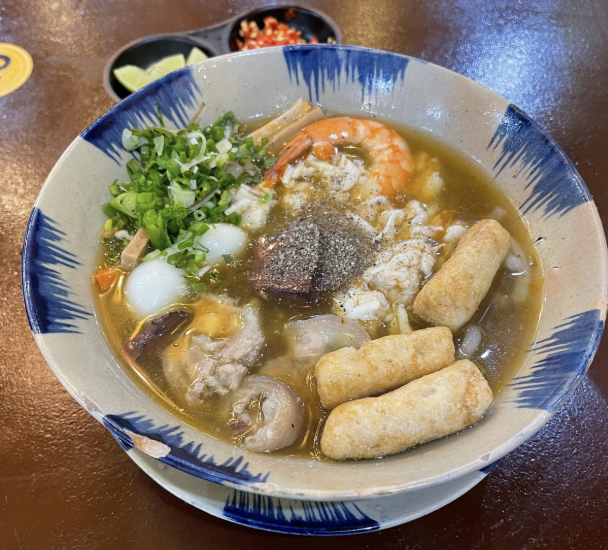For some, food is mere sustenance, something that is taken for granted. For others, it is an artifact to express who they are. Chris Blendheim, AP Seminar teacher, shared a dish that represents his identity at this point of his life: Bánh Canh Ghẹ.
“Wherever you may be, there you are,” Mr. Blendheim said, reflecting on the life-long philosophy his Norwegian grandfather held as a halibut longliner. “It means wherever you are living, you are still the same person with the same values.”
Growing up in Seattle, Mr. Blendheim’s childhood was filled with the tastes of the Pacific Northwest—fresh seafood and halibut filet prepared by his grandfather who frequently sailed the icy waters between the Alaskan Aleutians and Seattle.
“I ate seafood like a Viking, and I still do,” Mr. Blendheim said. His early connections to the ocean are still a part of his identity that has never faded. In every place he has called home, seafood connects him with his root which was deeply influenced by his grandfather’s far-reaching legacy. Even as he lives abroad in South Korea, Mr. Blendheim tries to stay close to his identity. “In Korea, I gravitate to port towns and fishing towns like Tongyeong and eat whatever from the freshest catches.”

However, the dish that has come to represent his identity today is found in the heart of Saigon, embodying Mr. Blenheim’s connection to Vietnam’s vibrant culture and his evolving identity. Bánh Canh Ghẹ, with its fresh crab and thick, silky noodles, mirrors the freshness and care his grandfather instilled in him. For Mr. Blendheim, this dish is not just a meal—it’s a bridge between his past and present, a reminder of home, and a celebration of the discovery that comes with embracing a new culture. Sitting on a flimsy red plastic stool six inches off the sidewalk, Mr. Blendheim enjoys having Bánh Canh Ghệ, a soup with thick tapioca or rice flour noodles and fresh crab.
Bánh Canh Ghẹ, in all of its variations, has become an Eastern reflection of Mr. Blendheim’s evolving identity. What draws him to Bánh Canh Ghẹ is not just the rich, complex flavor of the broth, but the experience it provides—the local, familiar scent, the crowded streets, the whirling motorbikes—that mirrors his own adventurous life.
“I spend as much time in Vietnam as I can,” Mr. Blendheim said. “I have discovered the joys of motorcycling in Vietnamese cities and the countryside, struggling with their impenetrable language, sipping egg coffee, and dining on Saigon oysters, snails, and all varieties of phở. The dish combines the comfort of seafood I’ve known all my life with the vibrant, chaotic energy of Vietnam, making it deeply personal. It reminds me of the adaptability and curiosity my grandfather instilled in me while celebrating the new flavors and stories I’ve discovered here.”
Amid the hustle and bustle of Vietnamese life, Mr. Blendheim finds Bánh Canh Ghẹ to be a dish that defines him at this pivotal moment in his life.

(Fun Fact):
As a Seattleite who maintains a steady level of caffeine in his system, Mr. Blendheim likes enjoying his Bánh Canh Ghẹ with a cà phê trứng (espresso topped with egg yolk and sweetened condensed milk that had been whipped for ten minutes into an airy, creamy meringue). 
Below is the recipe for Bánh Canh Ghẹ
(Recipe adapted from: Vicky Pham)
Ingredients:
Broth
1 large yellow onion or 4 shallots (leave whole)
3 lb pork bones (neck bones and/or spareribs)
1 teaspoon (for cleaning) plus 1 tablespoon sea salt (for stock)
3 quarts water
1 small daikon (peel and cut into chunks)
2 tablespoons chicken bouillon powder
1 tablespoon plus 1 teaspoon granulated sugar
1 teaspoon fish sauce
1 tablespoon annatto oil
1/4 cup tapioca starch
1/2 cup cold water
Noodles
2 lbs Banh Canh (thick tapioca or rice noodles)
1/2 teaspoon sesame oil
Meat Toppings
1 lb cooked crab meat
1 tablespoon annatto oil or neutral oil
1 teaspoon minced garlic
15 cooked shrimp (size 21-25, peel and devein)
Garnishes
Ground black pepper
2 scallions/green onions (slice thinly)
Small bunch cilantro (slice thinly)
Fried shallots
1 lime (cut into wedges)
2 tsp sugar
1/2 tsp black pepper
8 oz fried tofu
Beansprouts
Cilantro, chopped
Banana blossom, thinly sliced and place into a lime juice water
Water spinach
Green lettuce, sliced
Perilla leaves
Lime wedges
Fish sauce and Thai chili mixture (optional)
Shrimp paste (optional)
Instructions
Roast onion/shallots in the oven at 350°F for about 40 minutes or until soft. Allow them to cool then peel/scrap off all charred areas to prevent browning the broth. Set aside.
Clean the pork bones thoroughly: Add the pork bones to a large stock pot and fill with water to cover by 1 inch. Add salt (1 teaspoon). Parboil the bones for 8 minutes or when you see a lot of foam forming. Drain the contents of the pot into a colander placed in the sink and rinse bones under cold running water. This cleaning will keep the stock clear. It also helps to get rid of the foul pork smell.
Make the stock: Clean the pot thoroughly and return to the stove. Add water (3 quarts), cleaned pork bones, roasted onion/shallots and daikon. Bring the pot to a boil and reduce the heat to a very low simmer. Cook for 1 hour, uncovered. Remove onions/shallots and daikon from the pot and discard.
Season stock with stock bouillon powder, sugar, salt (1 tablespoon) and fish sauce. Add annatto oil and/or food coloring to the stock for color (optional).
Thicken the broth: In a small bowl, mix tapioca starch and water (1/2 cup) until completely dissolved. Add slurry to broth and simmer for an additional 5 minutes to thicken.
Cook the noodles per packaged instructions. Toss gently with sesame seed oil to prevent sticking.
Prepare the crab. Heat annatto or neutral oil (1 tablespoon) in a small skillet at medium-high. Add garlic and pan-fry until fragrant. Add cooked crab meat and lightly sauté until colored and aromatic. Set aside.
Assemble: Add a handful of Banh Canh noodles into a bowl. Ladle broth over noodles. Add 2 or 3 shrimp, desired amount of crab meat and pork spare ribs from broth. Garnish with a sprinkle of black pepper, scallions/green onions, cilantro and fried shallots. Serve with a wedge of lime on the side and enjoy.


